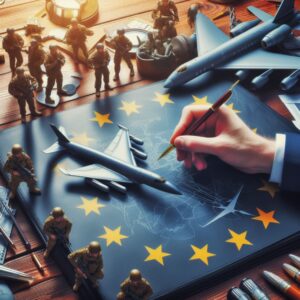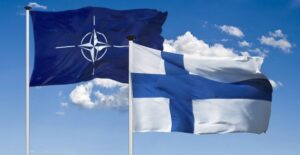- Part of the power of a country’s military strength can be measured by its ability to send and sustain troops abroad.
- In geopolitics, states can use hard power to project their strength and influence.
- In international politics, strong nations with the ability to persuade and coerce tend to be most favored in negotiations.
A country’s sphere of influence in the international community is measured by several factors, such as its cultural, economic, military and political projection.
Although alliances and formal treaties exist between countries with greater and lesser power of persuasion, these treaties are not necessary for the power projection of a State to be exercised.
Thus, one of the most used forms of power projection in the geopolitical environment is war, that is, the projection of military power.
Unlike soft power, which involves shaping the preference of other states through non-coercive appeal, force projection aligns with the concept of hard power in International Relations, to promote its geopolitical influence vis-à-vis other countries.

What is Force Projection and why is it important?
The projection of force (or power) is defined by military science as the capacity that a country may have to insert and maintain its military forces outside its borders, having the means to produce an expeditionary war.
In fact, all countries capable of deploying military forces abroad have some level of power projection, however, this term is most often used when referring to military forces with a worldwide reach.
This important capability can serve as an immediate effect through influencing the decision-making of other countries. In addition, it can also be used as a deterrent to certain unwanted behaviors by other states, therefore, a form of hard power use.
What are the countries with the greatest international military projection?
Generally speaking, only a few countries have the capacity to overcome the logistical difficulties that the movement and deployment of military forces abroad requires.
This form of power requires, in addition to a strong economy and technology, a well-consolidated “blue water navy” capability. The attributes of this privilege are the ability of a fleet to operate on the high seas, far from its home base.
In this way, the State can provide force protection against maritime and air threats, in addition to a sustainable logistical reach that allows a military presence on the high seas and, according to the military, a true blue water navy is the one that has the capacity to refuel at sea.
In analysis, the presence of the maritime force abroad in a global way ends up reinforcing the projection of power of the States that possess such technologies.
However, it is not only through naval power that a country can project its military forces beyond its borders. The size and power of a country’s tactical airlift, which measures the ability to deploy troops and logistical support to theaters of operation via air, is also used to measure a country’s deployment capability.
In a practical way, according to the 2022 world ranking by Global Firepower, the 15 countries with the highest power projection are:
- United States
- Russia
- China
- India
- Japan
- South Korea
- France
- UK
- Pakistan
- Brazil
- Italy
- Egypt
- Turkey
- Will
- Indonesia
The military classification of the 15 member states with the greatest military strength of NATO, obtained the following classification:
- United States
- France
- UK
- Italy
- Turkey
- Germany
- Spain
- Canada
- Poland
- Greece
- Norway
- Netherlands
- Romania
- Czech republic
- Portugal
Consequently, the countries cited are those with the greatest capacity to exercise hard power and the most geopolitically influential, due to their military forces.
Not everyone has a blue water navy, however, it is the States that have the possibility of achieving this privilege more quickly compared to countries outside these lists, either by sea, air or land.
What is Hard Power commonly used by NATO and Russia?
In geopolitics, hard power is applied when a country uses its military forces and economic means to persuade another nation, and its political bodies, to act in the interests of the first.
This form of power projection can often be aggressive, being used as a form of coercion, and becomes more effective when imposed by a State on another with lesser military or economic power.
As an example, these are some demonstrations of how hard power works in practice:
- Showing the flag: through the insertion of military forces in a certain region, to demonstrate political interest, or the desire to initiate stronger military action at an opportune moment.
- Compulsion/confrontation: through the use of the threat of military force against another country, to induce or dissuade it from following a particular political agenda. In this way, power projection acts as an aggressive diplomatic tool, trying to influence the decision-making access of foreign actors.
- Punishment: that of force against another state to punish it in response to its decision for a particular political agenda.
- Armed intervention: the movement of military forces into the territory of another state with the aim of influencing the internal affairs of the target country, or even outright conquest.
- Conquest: The offensive use of military assets to forcibly occupy territory controlled or claimed by another nation.
In this scenario, the contrast between hard power and soft power is visible, since the latter comes from diplomacy, culture and history, seeking to resolve conflicts through treaties and agreements, preserving peace.
In the context of power projection, it is observed that NATO makes ample use of this tool in geopolitics. The North Atlantic Treaty Organization is known around the world as the strongest and most powerful alliance in the world and despite not having its own Armed Forces, it has a permanent and integrated military command structure.
The military alliance structure is made up of military and civilian personnel from all member states and these teams work collectively to achieve the same geopolitical objectives, generating an immense advantage over their target countries.
Each member state agrees to contribute different strategic weights and influences. Furthermore, allies make direct and indirect contributions to the costs of running NATO and implementing its policies and activities, generating a mutual benefit for members.
In the case of Russia, the most evident and current example of hard power is the invasion of Ukrainian territory by its troops, to protect what the Russian State considers as one of its main national interests.
However, likewise the US invasion of Afghanistan, Iraq, Libya and Syria were similar exercises in the use of hard power, motivated by regime change goals and other national interests allied with the US and NATO.
Why is force projection important to measure a country’s geopolitical power and its worldwide influence?
In international political theory, a strong country is one that has the ability to impose its will on other countries through persuasion or military force. That is, through soft power or hard power depending on the political situation.
In this way, alliances between nations can be induced or voluntary and demonstrate an important facet of the different types of power of a State, or its limitation.
Countries that do not hold this kind of power are often at the mercy of the decisions and consequences of more powerful states, which end up influencing geopolitical conditions at a regional and global level. Or even become the targets of the power projection of such powers.
Paraphrasing the metaphor of the former US Senator, Michael Enzi, in the context of international negotiations and the power of persuasion – be it through diplomatic means or by projection of military force – it can be said that: “if you are not at the table, you are on the menu“.


日軍第731部隊旧址_PB121201-e1713902593308-300x224.jpg)








[…] said, it is possible to understand the Australian engagement in the search for alliances that can collaborate with regional security and […]